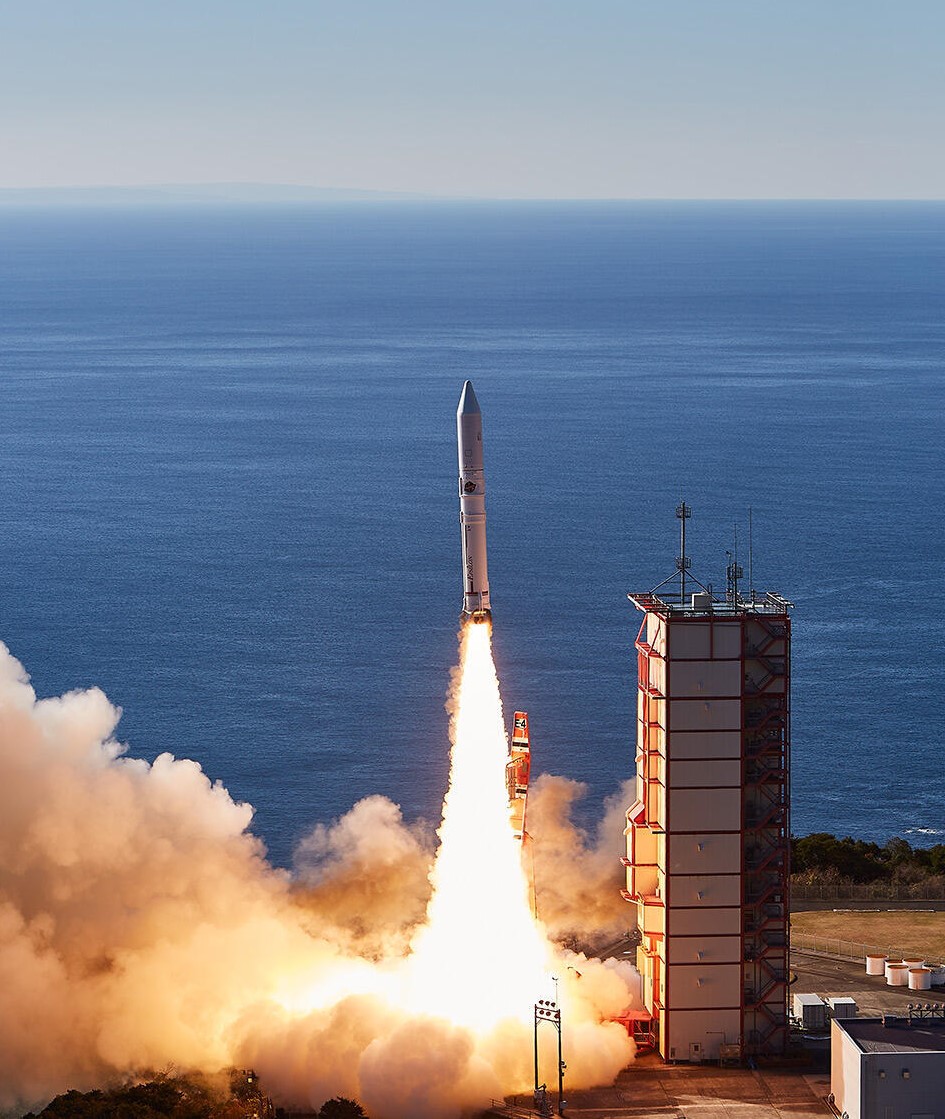
Epsilon
ActiveJapan Aerospace Exploration Agency (JAXA)
Sept. 14, 2013
Description
The Epsilon rocket is a Japanese solid-fuel rocket designed to launch scientific satellites. It is a follow-on project to the larger and more expensive M-V rocket which was retired in 2006. The Japan Aerospace Exploration Agency (JAXA) began developing the Epsilon in 2007. It is capable of placing a 590 kg payload into Sun-synchronous orbit.
Specifications
-
Minimum Stage
3 -
Max Stage
4 -
Length
24.4 m -
Diameter
2.5 m -
Fairing Diameter
2.5 m -
Launch Mass
91 T -
Thrust
2271 kN
Family
-
Name
Epsilon -
Family
― -
Variant
― -
Alias
― -
Full Name
Epsilon
Payload Capacity
-
Launch Cost
$39000000 -
Low Earth Orbit
― -
Geostationary Transfer
Orbit
― -
Direct Geostationary
― -
Sun-Synchronous Capacity
590 kg
Japan Aerospace Exploration Agency
Government
Administrator: Hiroshi Yamakawa
JAXA 2003The Japan Aerospace Exploration Agency (JAXA) is Japan's national aero-space agency. Through the merger of three previously independent organizations, JAXA was formed on 1 October 2003. JAXA is responsible for research, technology development and the launch of satellites into orbit, and is involved in many more advanced missions, such as asteroid exploration and possible manned exploration of the Moon. JAXA launch their Epsilon vehicle from the Uchinoura Space Center and their H-II vehicles from the Tanegashima Space Center.
Epsilon | RAISE-3 & others
Japan Aerospace Exploration Agency | JapanUchinoura Space Center, Japan
Oct. 12, 2022, 12:50 a.m.
Status: Launch Failure
Mission:
RAISE-3 (RApid Innovative payload demonstration Satellite-3) was a satellite for on-orbit demonstrations of 7 demonstration components and equipment selected by public solicitation. The satellite was to be operated in response to requests from the demonstration theme proposers, and will provide experimental data of the demonstration devices and environmental data during the experiments. The launch is also carrying QPS-SAR 3 & 4 radar Earth observation satellites for iQPS, and 5 cubesats for various Japanese institutions & companies.
Sun-Synchronous OrbitEpsilon | RAISE-2 & others
Japan Aerospace Exploration Agency | JapanUchinoura Space Center, Japan
Nov. 9, 2021, 12:55 a.m.
Epsilon | RAPIS-1 & others
Japan Aerospace Exploration Agency | JapanUchinoura Space Center, Japan
Jan. 18, 2019, 12:50 a.m.
Epsilon | ASNARO-2
Japan Aerospace Exploration Agency | JapanUchinoura Space Center, Japan
Jan. 17, 2018, 9:06 p.m.
Epsilon | ERG (ARASE)
Japan Aerospace Exploration Agency | JapanUchinoura Space Center, Japan
Dec. 20, 2016, 11 a.m.
Status: Launch Successful
Mission:
The ERG  (Exploration of energization and Radiation in Geospace) project is a mission to study the Van Allen belts. The task is to elucidate how highly charged electrons are born while they generate and vanish repeatedly along with space storms caused by the disturbance of solar wind, influenced by space storms, and how space storms are developed.
Elliptical OrbitEpsilon | Hisaki (SPRINT-A)
Japan Aerospace Exploration Agency | JapanUchinoura Space Center, Japan
Sept. 14, 2013, 5 a.m.
Status: Launch Successful
Mission:
Hisaki, also known as the Spectroscopic Planet Observatory for Recognition of Interaction of Atmosphere (SPRINT-A) is a Japanese ultraviolet astronomy satellite operated by the Japan Aerospace Exploration Agency (JAXA). Hisaki carries an extreme ultraviolet spectrometer which will be used to study the composition of the atmospheres and the behavior of the magnetospheres of the planets of the Solar System.
Low Earth OrbitLong March 5
Chang'e 6
101 - Wenchang Space Launch Site, People's Republic of ChinaChang'e 6/CE-6 is scheduled to launch in 2024 to return samples from the Far Side of the Moon (near southern edge of the Apollo Basin) for the first …
SR75
Maiden Flight
Pad 1 - Koonibba Test Range, South AustraliaTest flight of HyImpulse's SR75 sounding rocket
Falcon 9
Starlink Group 6-55
Space Launch Complex 40 - Cape Canaveral, FL, USAA batch of 23 satellites for the Starlink mega-constellation - SpaceX's project for space-based Internet communication system.
Falcon 9
WorldView Legion 1 & 2
Space Launch Complex 4E - Vandenberg SFB, CA, USAWorldView Legion is a constellation of Earth observation satellites built and operated by Maxar. Constellation is planned to consist of 6 satellites …
Falcon 9
Starlink Group 6-54
Space Launch Complex 40 - Cape Canaveral, FL, USAA batch of 23 satellites for the Starlink mega-constellation - SpaceX's project for space-based Internet communication system.

